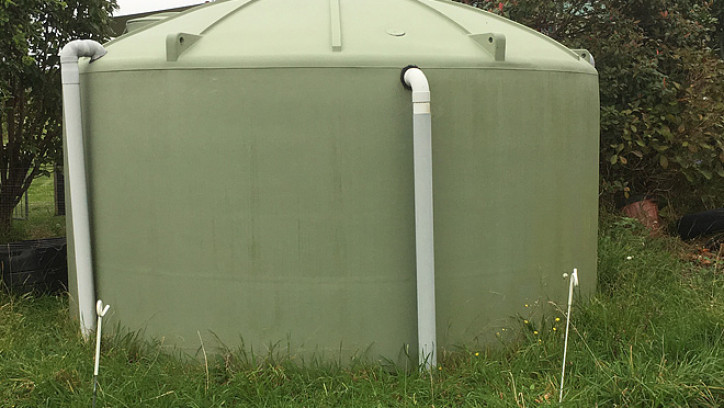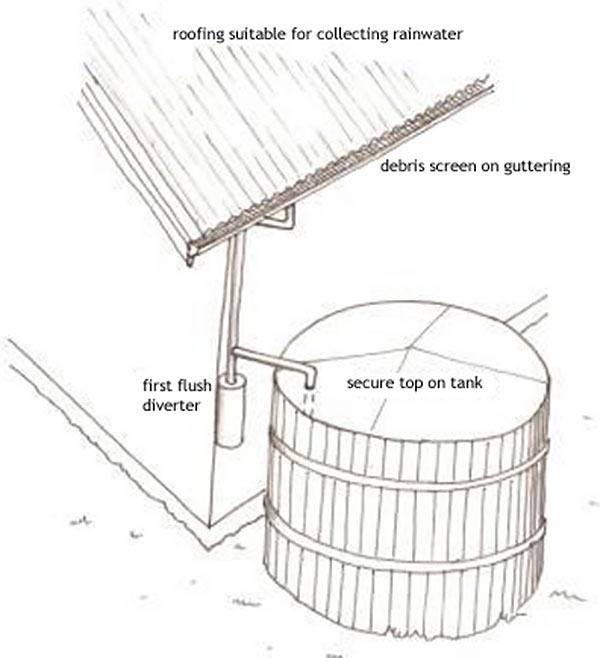Collecting and using rainwater
Last updated: 9 August 2023

Rainwater is a free, perpetually renewing water supply.
Harvesting rainwater
Installing a rainwater tank is relatively simple and inexpensive, and the benefits are ongoing.
Rainwater is a good source of water for using on your garden. It can also be used for washing your clothes, flushing the toilet, and – if it's properly treated – for drinking and other household uses.
Is it for me?
If your property isn't connected to a mains water supply, or is located a long way from your mains water supply, rainwater may be the most viable water supply.
Even if you're connected to the mains water supply, you may want to consider using rainwater for your garden or for other household uses. By doing this, you may be able to reduce your demand on mains water supply and in some areas water charges.
How do you collect and use rainwater?
In principle, a rainwater collection system is simple: rainwater is collected from your roof and stored in a tank until you need it.
Exactly how you set the system up will depend on how much rainwater you need and what you want to use it for.
To collect rainwater for watering the garden, you might not need anything more complex than a 44-gallon drum or a 200-litre rain barrel with a tap or connection to a soak hose. Generally, systems for outdoor use only rely on gravity with no need for pumps.
You can also collect rainwater for:
- flushing your toilet and doing your laundry
- other household uses such as drinking, bathing and using in the kitchen (but the water will have to be treated or purified).
Legal requirements
Some councils will only let you use rainwater for potable purposes (eg. drinking and bathing) if it has been treated. It is best to check what your council's requirements are before you start. There is usually no problem with installing smaller tanks for just garden watering.
If you're connecting a rainwater system to the plumbing of a house that also has a mains supply, you will need a building consent. You are also required by law to ensure that the mains water is isolated from the rainwater system. This is achieved by using a backflow prevention device. A qualified plumber must install this and you may be required to have annual checks on this device.
Most councils will require you to connect to the mains water if there is a connection available, even if you will only use it as a backup.
TIP - Do I need consent?
You may also need a consent to install the tank if it's very large or elevated. Check the rules with your local council.
Choosing the right rainwater system for you
How big?
To calculate the size of tank you'll need, consider:
- the annual rainfall in your area
- what you intend to use the water for
- whether you have access to mains water supply.
You don't need to have a huge tank to make a difference – even a rain barrel will reduce your outdoor water use and provide water in an emergency. Some councils sell these, so check with yours.
For garden watering, you can install either a rain barrel (generally about 240 litres) or a rainwater tank (500 litres +). In areas such as Auckland, with year-round rainfall, a smaller tank might be enough for the garden. If you live in an area with dry summers, or you water your garden a lot, you will need a larger tank.
If you are planning to use rainwater for indoor supply, you will need a larger tank. In areas with year round rain, a 5000-litre tank will provide a good proportion of your water use. In areas with dry summers, you'll need a much larger tank (10,000 litres +).
If rainwater is your sole source of water, you will need at least a 30,000-litre rainwater tank. Talk to your local suppliers to find out the size that would best suite your climate and household.
Other factors that might influence the size of your tank include:
- the size of your property – a large garden will need more water
- the size of the collection area
- how reliant you are on the water supply
- how efficient your water using appliances and plumbing fittings are.
If you live in the city and are short of space, you could install a slim-line tank that fits alongside and attaches to a wall on the side of your house. Water is heavy, so even slim-line tanks need to be well supported.
Contact your local rainwater tank supplier (you could search for 'water storage' and 'tank manufacturers' using an online search tool or ask your local council for advice on the capacity of your rainwater tank.
Tank materials
The most common tank materials are plastic (polyethylene), concrete, and coated steel. The type of material you select depends on your budget, the size of tank, water use and whether the tank will be sited above or below ground.
Modern steel tanks have a long life polymer coating on the inside and a wide range of shapes and sizes are available. There are a range of slim-line designs suitable for urban sections available. Concrete tanks are strong and can be sited below the ground. Plastic is tough, durable and relatively lightweight, and – like steel – there are a wide range of sizes and shapes suitable for urban environments.
Other types of tanks include fibreglass and timber. Timber tanks have a plastic bladder liner, and generally come in larger sizes.
In-ground tanks
Consult a structural engineer if you are considering placing the tank in the ground. Concrete tanks are usually chosen for this purpose.
Other considerations
Gravity-fed systems (which don't rely on a pump) will need the barrel or tank on a stand. Because a litre of water weighs a kilogram, a rainwater tank stand needs to be fairly robust, and should be concreted into the ground. It will need to be over 30cm but less than one metre high – tanks on stands over one metre high generally require a building consent.
A rainwater system supplying the house will need a pump to operate.
When designing your rainwater system, remember to include a first-flush device, an overflow outlet (see Rainwater tank overflow below), and provide access for cleaning.
Costs
A basic rainwater collection tank is easy to install and can be relatively inexpensive. Costs vary depending on the tank material, and installation and delivery requirements.
Other costs may include the pipes, filters or treatment, any plumbing requirements, building consent fees, and annual inspection fees.
Rainwater tank overflow
There's a risk of overflow from rainwater tanks that are poorly installed or aren't big enough to cope with runoff from the roof. Overflow needs to be contained on your property or diverted to the stormwater system. Otherwise, overflow from your tank could damage your property and neighbouring properties, especially in built-up areas. If damage occurs, you could be liable.
Setting up for garden watering
To collect rainwater for your garden, any large, opaque, watertight container will do. Many tanks are dark-coloured to prevent light penetrating the tank and encouraging algal growth.
Set the tank up so the downpipe from your roof feeds into it, and cover it with a strong insect screen to stop mosquitoes invading and animals from getting trapped. In periods of high rainfall you may need to reconnect your downpipes to the stormwater system to prevent overflowing.
You can fit a tap to the container, or fit a soak hose or 'dripper' irrigation system to it. If you use a tap, put a lock on it so children can't drink the water. A warning sign is also a good idea.
Safety
Collected rainwater can contain:
- leaves, soil and other debris
- bird, possum and other animal droppings
- heavy metals such as lead from your roof and roof paint
- ash and chemical residues – for example, from agricultural spraying and vehicle emissions.
To protect your health, you'll need to ensure your rainwater system is properly set up and maintained.
Roof materials and pipes
Some roofing materials aren’t suitable for rainwater collection. Check with the manufacturer.
If there's lead, chromium or cadmium in the roof materials, soldering, flashings, paint or any other part of the roof, you shouldn't collect rainwater from the roof.
Rainwater can also react with uncoated metal roofs, so any metal roof should be painted (using a roof paint that is labelled 'suitable for potable water supply') before rainwater is collected.

Typical rainwater system set up to minimise contamination.
Preventing contamination
A leaf filter helps keep your rainwater tank free from larger-sized contamination.
To prevent leaves, droppings and other organic matter from contaminating your rainwater:
- Use a 'first flush diverter'. This is a simple, inexpensive device that fits on to your downpipe or tank inlet. It prevents the initial flow of contaminant-laden water from the roof entering the tank when it rains. Contaminants drain off to the stormwater, or a suitably planted part of the garden or soakage area.
- Ensure the tank is tightly covered – this also prevents evaporation.
- Use a screen over the tank’s inlet pipe to keep out insects, birds and animals.
- Install gutter screens that prevent debris from entering the gutter but don’t stop water flow. Check that they don’t compromise your roof and gutter warranties and that they can themselves be cleaned easily periodically.
Treating and purifying water for drinking
If you want to drink your rainwater or use it for any household use other than flushing the toilet and washing clothes, you'll need to treat it or purify it. To do this, options include:
- adding chlorine
- using a very fine in-line filter or purifier
- boiling the water for one minute
- ultraviolet light treatment.
All of these options will add costs. Some councils also require periodic testing of rainwater tanks used for drinking water.
Check with your local council, your local public health service, or your rainwater tank supplier for water treatment requirements and guidance.
Drinking-water on the Minsitry of Health website has further information.
Testing
You can have water tested by a specialist water-testing laboratory. Search for 'laboratories' when using an online search tool. You should have drinking water tested annually.
TIP - Household water
You can download free booklets about water from the government's HealthEd website.
Water collection tanks and safe household water covers issues relating to tank water.
Household water supplies covers the selection, operation and maintenance of tanks and other individual household water supplies.
Maintenance
Regular maintenance is vital especially if you use rainwater for household use. Maintenance should include:
- desludging your tank annually – if there is one, use the sediment removal tap at the base of the tank (this should take about 20 minutes). Do not use a petrol or diesel water blaster in the tank because of the hazardous fumes
- checking the roof and guttering for debris
- keeping the roof clear of overhanging vegetation
- making sure your roof remains clean, especially from bird droppings
- regularly checking and maintaining screens and filters
- washing out the first flush diverter every two months or so, depending on your rainfall (this only takes 10 minutes)
- checking the condition of the tank's pipes, fittings and structural supports and inspecting the tank for cracks and leaks, particularly before it gets dry over summer.
- servicing any sterilisation equipment (as recommended by the supplier).
It's also a good idea to drain and clean your tank regularly. Every five years is recommended but will depend on what gets into your tank, and how often you remove sludge and sediment.